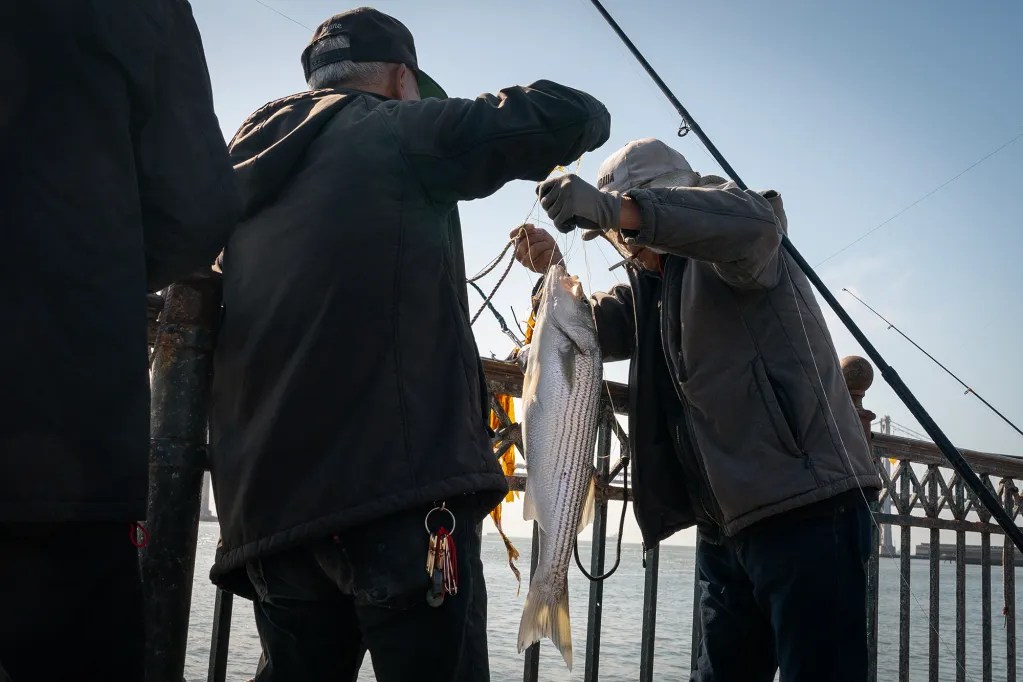By Rachel Becker, CalMatters
Linked to an array of health conditions such as cancers, heart disease and pregnancy disorders, per- and polyfluoroalkyl substances resist breaking down in the environment. Used by industries to make waterproof coatings, firefighting foams, food packaging and more, these chemicals have contaminated people and animals everywhere around the globe, including newborns.
Researchers from the San Francisco Estuary Institute found the chemicals in striped bass, largemouth bass, leopard shark, white croaker, white sturgeon and other fish collected between 2009 and 2019 throughout San Francisco Bay.
RELATED: The dangerous allure of Bodega Bay’s crab season
Recreational and subsistence anglers catch striped bass and the other fish from boats, shores or piers, but they are not sold commercially. Many Asian immigrants, other people of color and low-income people fish in the bay to feed their families.
Related Articles
Trump budget would cut ocean data and leave boaters, anglers and forecasters scrambling for info
Why a contentious project to raise California’s Shasta Dam could move forward under Trump
Fishermen battling with changing oceans chart new course after Trump’s push to deregulate
An ugly dead fish missing one eyeball is drawing crowds at California aquarium
50-year legacy: Vietnamese boat people thrive as Monterey fishermen
California has set health advisories for other contaminants in fish, but not for these “forever chemicals.” Based on Massachusetts’ advisory — the most stringent in the country — 83% of the fish tested are considered unsafe to eat daily, and a third of the fish would not be safe to eat even in amounts of half a pound a week, the researchers said.
The chemicals seep into soil and wash into waterways that flow into the bay from landfills, airports, industrial sites, military bases and sewage treatment plants.
“All along the shoreline of San Francisco Bay, especially along the Carquinez, we see how many polluting industries are there. Yet people still fish there and, because of finances, many people eat that fish,” said LaDonna Williams, a program director with the Bay Area-based environmental justice nonprofit All Positives Possible. “Do you just close your eyes and pray over your food? … That’s a heck of a decision to have to make.”
The findings, published in the scientific journal ES&T Water, build upon earlier reports that “forever chemicals” are among the cocktail of contaminants in San Francisco Bay.
The chemicals are likely contaminating ocean fish throughout California, but no statewide studies have been conducted.
“We know already that (these chemicals) are impacting all of us,” Miguel Méndez, an environmental scientist who was a co-author of the study, said in a press release. “But we also know that there’s a lot of communities in the Bay that fish, and a lot of these communities tend to be underrepresented and more marginalized in the Bay.”
State officials have already posted signs at San Francisco Bay piers to warn people to limit or avoid consumption of certain fish because of other contaminants, including mercury, a potent neurotoxin that is a legacy of the Gold Rush.
Rebecca Sutton, managing senior scientist at the San Francisco Estuary Institute and an author of the study, said those warnings are likely protective for “forever chemicals,” as well.
A warning sign about fish consumption is posted at Pier 7 in San Francisco on June 21, 2024. Striped bass are a common species reeled in by anglers at the end of the pier. Photo by Loren Elliott for CalMatters
But fishing and environmental groups say California needs to set guidelines for what levels of the chemicals are unsafe, which will determine advice for how much people may eat.
Wesley Smith, senior toxicologist with California’s Office of Environmental Health Hazard Assessment, told CalMatters that the agency is developing guidance for perfluorooctane sulfonic acid, known as PFOS, although there is no timeline yet.
About 91% of the San Francisco Bay fish samples tested with the most advanced methods contained PFOS, used in some upholstery, carpets, cookware and firefighting foams beginning in the 1940s. It was phased out in the United States in the early 2000s because of potential health effects.
RELATED: Fishermen battling with changing oceans chart new course after Trump’s push to deregulate
Smith said the other states that took early action may have been concerned about high levels found in some areas. “We’re in a better position to move forward” in California, he said, because of the work by other states and the new analysis released today.
Smith advised people to follow the warning signs and eat smaller and younger fish to reduce their exposure.
Levels of the chemicals in San Francisco Bay fish were similar to those found in marine fish in some other harbors nationwide, but generally lower than freshwater fish caught in rivers, streams and lakes. The researchers tested the fish for 40 of the chemicals — a tiny fraction of this vast class — and found 20 in fish collected in 2009, 2014 and 2019.
Chris Shutes, executive director of the California Sportfishing Protection Alliance, said in addition to setting advisories for these contaminants, state officials should prevent them from getting into the water in the first place.
A bill in the Legislature authored by state Sen. Ben Allen, a Democrat from El Segundo, would phase out the sale of certain products that have some forever chemicals intentionally added, such as ski wax, dental floss, products for children, cookware and food packaging. California has previously banned it in certain fabrics, cosmetics and food packaging.
“These results also show how critical it is to phase out non-essential uses” and also “improve monitoring and limit how much” gets into waterways, Tasha Stoiber, a senior scientist at the Environmental Working Group who has investigated the chemicals in freshwater fish, said in an email.
Fish caught in the southern reaches of the bay, from Redwood City to Milpitas and San Jose, were especially contaminated — with more than 80% exceeding Massachusetts’ threshold for one meal per week, compared to 8% in other parts of the bay.
Tides don’t thoroughly flush out the runoff and treated sewage that carry the chemicals into the southern portion of the bay, home to one of the largest wastewater treatment facilities in the West.
As old “forever chemicals” are phased out, new ones are still leaching into the environment. The research team found one chemical that has never before been documented in marine fish.
No one knows how many people eat fish caught in the bay. Though nearly a quarter million anglers from Bay Area counties purchased licenses to fish in California in 2024, no one had tallied all people who fish from shorelines, piers, jetties or breakwaters — and there are no official counts of people whose families would go hungry if they didn’t.
One 25-year-old survey from the San Francisco Estuary Institute reported that Asian men make up a higher proportion of Bay Area anglers compared to the region’s demographics. Another study, farther upstream, reported Southeast Asians ate the most fish caught in the Delta, followed by African American and Hispanic anglers, who were exposed to much higher levels of mercury than recommended.





